Looking Back, August 2023
By Mark Albertson
Army Aviation:
Some Gems from Art and Dottie, 1959
“The Coop That Flew”
Development of a new highly mobile, air transportable communications center, designed to direct fast moving U.S. Army forces was announced recently by the Department of the Army. The system, which has an extremely high degree of mobility, can be set down almost anywhere by helicopters, and be flown out immediately for relocation elsewhere. It can also be moved rapidly from place to place on conventional Army trucks.
Developed by the U.S. Army Signal Corps, it provides the vital nucleus for a communications network of radio, telephone, telegraph and teletypewriter combat links.
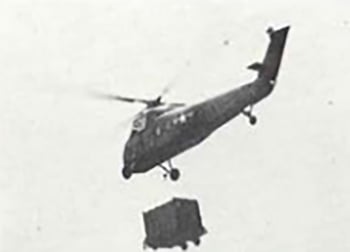
The system can be carried by helicopters to a remote destination in hours rather than days, or can be set up on otherwise inaccessible mountain tops. With its communications tentacles spread over hundreds of miles, the new system can get an urgent message through to a distant outpost even with direct lines broken or destroyed.
Speed and flexibility in communications would be vital on a battlefield where troops would have to be continuously on the move and widely dispersed to avoid annihilation by a nuclear warhead.
For prompt transportation and added versatility, the center is made up of separate aluminum houses or “shelters,” each fully equipped and independent. These can be hooked up quickly to fit any battle situation. Small centers for the front lines would have two or three shelters; larger headquarters would have as many as 24.
Each shelter carries its own independent supply of electricity, but can also plug into a central power source.
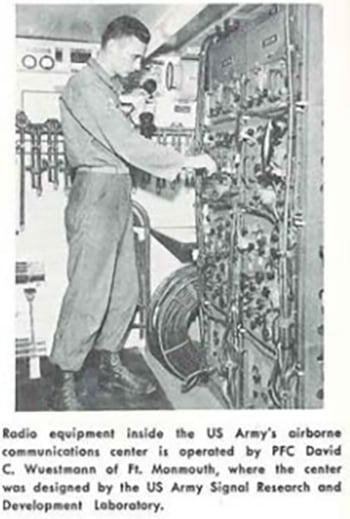
High priority combat messages flowing into the center from combat groups and other sources would be immediately available to the Army field commander. And the same network of communications lines carries his message with reflex speed to higher headquarters or to hard-hitting Army combat elements.
The new system, the first fully air transportable message center of its kind, is the result of 12 years of design and research.
Source: Page 8, Army Aviation, Vol. 7, No. 1, Army Aviation Publications, Westport, Ct., January 24, 1959.
* * * * *
A look at how unmanned aerial vehicles used to be with, “Snooper.”
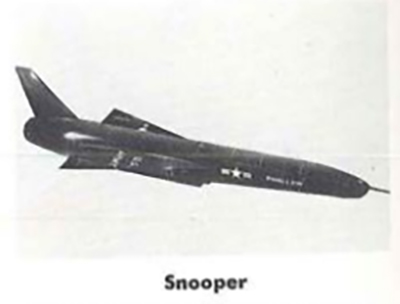
A small turbojet and pilotless aircraft that can swoop over the battlefield to gather military information is one of the newest surveillance drones under Army development.
The drone—called SWALLOW and designated SD-4 by the Army—will use a variety of advanced techniques for military surveillance purposes, including radar, infra-red and photography.
The SWALLOW is being developed and produced by Republic Aviation Corporation’s Guided Missile Division for the Army Signal Corps under a $25,000,000 contract. The contract calls for detail design and production of both the new drone and ground control units.
Source: Page 14, Army Aviation, Vol. 7, No. 1, Army Aviation Publications, Westport, Ct., January 24, 1959.
* * * * *
“Ingenious Is The Word For It!”
By Lieutenant John A. Means
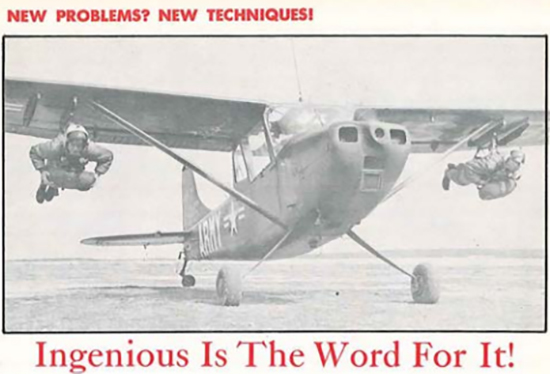
Can you tell when your leg is being pulled? Sometimes it is quite difficult to do so, especially in those instances when the raconteur backs up his “tale” with documentary evidence.
The envelope bore airmail postage and an official address. Here are the contents:
“The aviation platoon of Headquarters Troop, 16th Sky Cav, 2nd USAMC (M), now stationed at Fort Hood, Texas, is a unit that believes in developing new techniques to meet new problems.
Requirement Dictated Findings
In recent weeks the aviation platoon has had great need of a method of transporting several personnel over long distances to inaccessible areas.
The H-13 Sioux having certain range limitations and the larger helicopters and fixed wing aircraft being utilized in LARGE scale troop hauls precluding their use in smaller operations, the unit sought a vehicle that could deliver TWO troops to a confined area some 150 miles away and return. As always, the study called for low maintenance requirements and a low initial price.
Findings: the BIRD DOG!
Quick to adapt the equipment to the mission, fertile minds in the aviation platoon devised the ingenious piece of equipment as shown in the accompanying photo. An analysis of the possible missions for this hybrid revealed the following:
a) Delivery of replacements to squad-sized units.
b) Delivery of veterinarians to front-line war dog platoons.
c) Delivery of a chaplain (and assistant) with suitable card-punching equipment.
d) Delivery of COs to their units in those instances where map-reading deficiencies are expected.
Additional Uses
Additional uses for this equipment are expected to come to light with the passage of time. Equipping the two “wingman” with weapons could provide fairly accurate suppressive fire. Paymasters and couriers could be speeded to their objectives, the airfield to headquarters runs being obviated.
We offer this development to “Bird Dog” users throughout the world. We feel certain that they will see the simplicity involved in this development.[1]
Source: Page 123, Army Aviation, Vol. 7, No. 3, Army Aviation Publications, Westport, Ct., March 18, 1959.
[1] The use of two passengers or “wingmen” brings to mind an observation offered by the remarkably astute Benjamin Franklin, after he had observed the Montgolfier Brothers balloon floating across Paris, November 21, 1783.
“It appears, as you observe, to be a discovery of great importance, and what may possibly give a new turn to human affairs. Convincing sovereigns of the folly of wars may perhaps be one effect of it, since it will be impracticable for the most potent of them to guard his dominions. Five thousand balloons, capable of raising two men each, could not cost more than five ships of line; and where is the prince who can cover his country with troops for its defense as that ten thousand men descending from the clouds might not in many places do an infinite deal of mischief before a force could be brought together to repel them?” See page 598, “On War From the Air,” Vol. 2, Benjamin Franklin’s Autobiographical Writings, Viking Press, New York, 1945, by Carl Van Doren.
* * * * *
“Collins Develops Radical Aircraft”
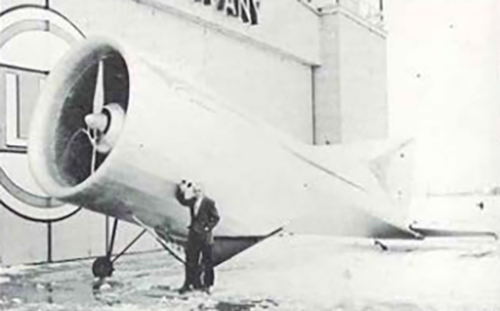
Developed jointly by the U.S. Army Transportation Corps and the Office of Naval Research, the first full scale model of the “Aerodyne,” a radical wingless VTOL aerial vehicle is shown with its designer, Dr. Alexander Lippisch, during a roll-out at Collins Research Laboratories, Cedar Rapids, Iowa.
Incorporating a new philosophy in aircraft design, the “Aerodyne” achieves vertical take-off and landing capabilities, and transition to and from forward flight, by channeling the airflow (thrust) from its two-contra-rotating propellers internally through the craft’s fuselage, and deflecting downward and out through controllable vents in its belly. The need for wings is eliminated by this propulsion method.
Directional control of the Army-Navy developed “Aerodyne” is governed by a conventional rudder and elevator. The cockpit (not shown) will be located aft under a canopy in the vertical stabilizer.
The experimental aircraft is scheduled for early shipment to Ames Laboratory at Moffett Field, California, where it will undergo full scale wind tunnel testing. Credited with the world’s first rocket-powered fighter, the Messerschmitt Me 163, Dr. Lippisch led the Collins research team responsible for the “Aerodyne’s” design and construction.
Source: Page 130, Army Aviation, Vol. 7, No. 4, Army Aviation Publications, Westport, Ct., April 20, 1959.







